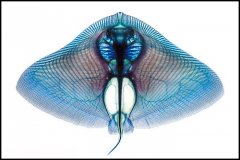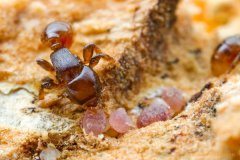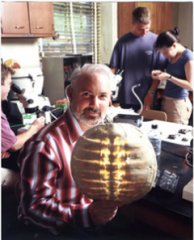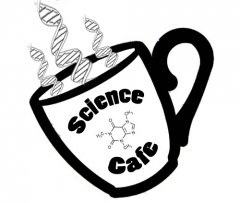News & Announcements
Cleared: The Art of Science
Cleared: The Art of Science
The Seattle Aquarium is currently hosting Cleared: The Art of Science, an exhibit of photographs by Adam Summers. The show features mesmerizing images of fish that have been specially treated to make the stained skeletal tissues visible through the skin and flesh. The technique, developed by Dr. Summers, uses dyes, hydrogen peroxide, a digestive enzyme and glycerin to make the flesh seem to disappear. Adam Summers was one of OEB's first PhD recipients, receiving his degree in 1999. He is currently a Professor at the University of Washington and Associate Director at Friday Harbor Laboratories. Between 2000 and 2008, he wrote columns on biomechanics for Natural History magazine.
2014 Darwin Fellow Search
2014 Darwin Fellow Search
A search for a new Darwin Fellow is underway. The Darwin Fellow Program, founded in 1995, brings promising young postdoctoral researchers to UMASS Amherst. The two-year position provides a unique combination of teaching and research responsibilities and is excellent preparation for academic positions. The fellowship program embodies the interdepartmental collaboration that characterizes the OEB Graduate Program. Darwin Fellows are active participants in OEB, acting as mentors to graduate students, conducting research, leading seminar courses, and teaching courses in the Biology Department. The position will start in August 2014. Details on the position and the application procedure can be found here.
Search update: four candidates have been invited for interviews in February.
Goodwin wins Best Presentation award at LSGRS
Goodwin wins Best Presentation award at LSGRS
Sarah Goodwin won the Best Presentation award for her talk "Shift of song frequencies in response to masking tones" at this year's Life Sciences Graduate Research Symposium. OEB was well represented, with five students giving talks. Congratulations!
PUBLICATION HIGHLIGHT: Scott Schneider
PUBLICATION HIGHLIGHT: Scott Schneider
Old McDonald Was an Ant?
It’s a common sight… ants and aphids crawling around together on rose stems. Sometimes they appear to be interacting, but it’s not always clear what’s going on. Even if you haven’t seen it yourself, perhaps you know the story. Many species of ants and aphids have mutually beneficial relationships. The ants act as bodyguards for the aphids, protecting them from predators, and the aphids reward the ants with a honeydew that they produce from plant sap. This mutualistic relationship centered around food, called trophobiosis, also occurs between ants and other insects, such as some butterfly larvae, treehoppers, and scale insects, though the reward isn’t always honeydew. But what’s occurring when ants are providing protection for species that don’t provide honeydew? What’s the reward? Scott Schneider, joint OEB/Entomology PhD Candidate at UMass Amherst, believes the reward for protection from ants is sometimes something much more macabre.
Schneider studies the interactions between the Afrotropical ant genus Melissotarsus and the armoured scale insects from the family Diaspididae. Schneider asks, “Is it crazy to think that the diaspidids (scale insects) themselves could be the food source?” This hypothesis was originally proposed almost forty years ago, but has been a source of contention ever since. While considered a plausible explanation by some entomologists, for others, well… “The idea of meat farming is a little too out there for them”, explains Schneider. However, he and his colleagues have recently provided new evidence to support this hypothesis in a recent edition of Systematic Entomology.
To try to understand more about this unique relationship, Schneider and his colleague Jan Giliomee from Stellenbosch University collected branches from trees in South Africa infested with colonies of the ant M. emeryi and the diaspidid Morganella conspicua and brought them back to a local field site for observation. They removed the bark from these branches to expose the tunnels where the ants and diaspidids live so they could observe their interactions. They also removed ants from some of the branches to let the diaspidids sit undisturbed for several weeks to see if the diaspidids were producing honeydew or wax for the ants to feed on.
They found nothing. No honeydew, no wax. What they did discover, however, were two unusual behaviors. One of the behaviors, in particular, got Schneider’s attention; a worker ant grabbed a diaspidid and pulled it until the diaspidid’s mouthparts were free from the wood, and then the ant set the diaspidid down. Without legs, the diaspidid had no way to reposition itself. This was a death sentence. Unfortunately, the ant was then attacked by another invading ant colony, so the ultimate fate of the diaspidid is still unknown. But Schneider wonders, “Was this a cultivating behavior?” Unfortunately, because the natural behavior of these insects is so difficult to study, it may be awhile before the mystery is solved. But the idea of an insect using another almost as “domestic cattle” is certainly intriguing; a coevolutionary relationship where the protection of many is paid for by the sacrifice of a few to sate the hunger of the protectors. Hollywood couldn’t imagine anything more fantastic.
http://people.umass.edu/scotts/schneider
Schneider, S. A., Giliomee, J. H., Dooley, J. W., & Normark, B. B. (2013). Mutualism between armoured scale insects and ants: new species and observations on a unique trophobiosis (Hemiptera: Diaspididae; Hymenoptera: Formicidae: MelissotarsusEmery). Systematic Entomology, 38(4), 805–817. doi:10.1111/syen.12033
Casey Gilman
Five OEB students presenting at Life Sciences Graduate Research Symposium
Five OEB students presenting at Life Sciences Graduate Research Symposium
Sarah Goodwin, Caroline Curtis, Melissa Ha, Dina Navon and Skye Long will all be presenting their research at the 3rd annual Life Science Graduate Research Symposium. The all day symposium, featuring a total of 18 presentations by students in nine UMass grad programs, takes place in Campus Center 101 on Friday, November 22. Following the talks, a poster session and reception takes place on the 11th Floor of the Campus Center from 4:30 - 6:00 p.m. Awards for best talk and best poster will be presented at the end of the reception. Symposium details can be found here.
Sinauer Associates Lecture: Scott Gilbert
Sinauer Associates Lecture: Scott Gilbert
Dr. Scott Gilbert will give this fall’s Sinauer Associates Lecture on October 18 at 3:00 in 222 Morrill 2. His talk Extending Lynn's view: A new symbiotic biology combines his interest in developmental biology, evolution and the history of science. Dr. Gilbert is a professor of Biology at Swarthmore College and the University of Helsinki. He has written several textbooks, and is currently investigating a remarkable evolutionary novelty: how the turtle got its shell. Following the lecture, there will be a reception at the University Club.
The Sinauer Lecture series is sponsored by Sinauer Associates, Inc., publisher of college texts in biology, psychology and neuroscience.
Three OEB alums land positions at Arcadia University
Three OEB alums land positions at Arcadia University
Kara Belinksy (PhD, 2008), Chad Hoefler (PhD, 2005) and, most recently, Tobias Landberg (MS, 2003) have joined the Biology faculty at Arcadia University. The 4,000-student university is located outside of Philadelphia. Four of the school's 13 biology faculty are OEB-trained. Small world!
Science Café announces fall series
Science Café announces fall series
The Science Café series, organized by OEB grad students, is designed to facilitate an engaging science discussion outside university walls in an informative but relaxed atmosphere. Each event is focused on a single topic, with a guest speaker, quiz bowl, and questions and answer.
Science Cafés are held at Esselon Café in Hadley on Monday nights. All events start at 6:00 p.m. and are free.
For more info, see oebsciencecafe.org
Monday, September 9th
Some Like it Hot, with Dr. Bethany Bradley Climate change, invasions, and marauding honeysuckle.
Monday, October 7th
How to Scare a Spider, with Skye Long A spider’s view of the world.
Monday, November 4th
Live Wires: Bacterial Batteries, with Dr. Derek Lovley How to turn microorganisms into living fuel cells. Really.
Monday, December 9th
To the Sea (and back again), with Dr. Steve McCormick
Fresh water, salt water, lather, rinse, repeat. Migratory fish tackle major environmental challenges.
Moseley wins Allee Award at 2013 ABS meeting
Moseley wins Allee Award at 2013 ABS meeting
Dana Moseley is the winner of the 2013 Warder Clyde Allee Competition for Best Student Paper at the Animal Behavior Society's Annual Conference in Boulder, CO. Dana, who is defending later in August, is a doctoral candidate in the Podos lab. The award is given to the best presentation of an ethological work of research by a student in a juried competition held at their annual meeting. Congratulations Dana!
Goodwin awarded NSF DDIG
Goodwin awarded NSF DDIG
Sarah Goodwin, a doctoral candidate in the Podos lab, has been awarded a NSF Dissertation Doctoral Improvement Grant for her dissertation research "Assessment of Signals in Communication Networks." NSF’s DDIG program is designed to improve the quality of dissertation research by providing funds for items not normally available to doctoral students through their university.



